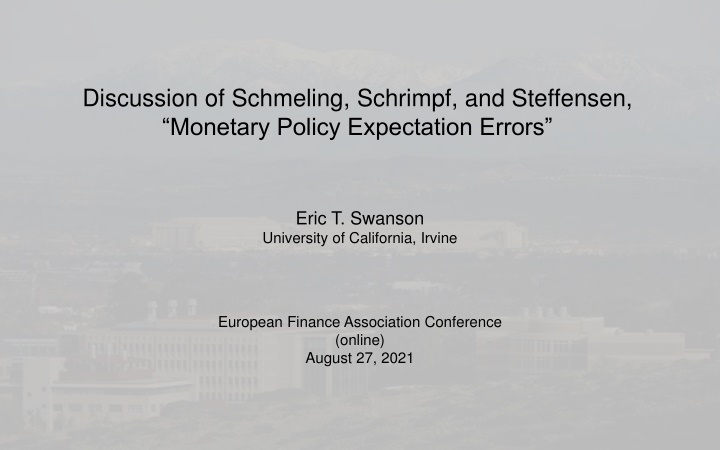
Market Forecast Errors in Monetary Policy Expectations
Explore the dynamics of market forecast errors in monetary policy expectations, highlighting the impact of underestimating the Federal Reserve's response to economic conditions. Learn how these errors affect risk premia and market outcomes across various economies.
Uploaded on | 0 Views
Download Presentation

Please find below an Image/Link to download the presentation.
The content on the website is provided AS IS for your information and personal use only. It may not be sold, licensed, or shared on other websites without obtaining consent from the author. If you encounter any issues during the download, it is possible that the publisher has removed the file from their server.
You are allowed to download the files provided on this website for personal or commercial use, subject to the condition that they are used lawfully. All files are the property of their respective owners.
The content on the website is provided AS IS for your information and personal use only. It may not be sold, licensed, or shared on other websites without obtaining consent from the author.
E N D
Presentation Transcript
Discussion of Schmeling, Schrimpf, and Steffensen, Monetary Policy Expectation Errors Eric T. Swanson University of California, Irvine European Finance Association Conference (online) August 27, 2021
Overview Summary of Paper: 1) Historically, there have been excess returns on money market futures and OIS contracts 2) Many previous papers have equated these excess returns with risk premia 3) This paper carefully separates excess returns into market forecast errors vs. risk premia, and shows that the former are dominant 4) Why did the market make forecast errors? The market seems to have underestimated how aggressively the Fed would respond to deteriorating financial conditions 5) All of these observations also hold more generally for the Eurozone, Japan, UK, Australia, Canada, and Switzerland
Market Forecast Errors vs. Risk Premia Previous researchers often assumed that expectation errors were zero or small on average (e.g., Piazzesi-Swanson, 2008) This paper shows that market expectation errors in fact were large and completely dominate ex post excess returns The empirical work in the paper is extremely solid and thorough. There is really nothing to criticize
Why Did the Market Make Such Large Forecast Errors? Market does not satisfy Full Information Rational Expectations (FIRE) In particular, market does not have full information about the Fed s monetary policy reaction function A lot of evidence that market underestimated how aggressively the Fed would respond to economy
Why Did the Market Make Such Large Forecast Errors? In particular, deteriorating financial conditions caused the Fed to ease by more than markets expected: Bauer-Swanson (2021) make a very similar observation: stock market returns are a strong predictor of subsequent high-frequency monetary policy surprises
Relationship to the Fed Information Effect Bauer-Swanson (2021) explanation for the Fed Information Effect : Bad economic news causes the Fed to ease by more than markets expected Bad economic news also causes Blue Chip forecasters to revise their GDP forecasts downward Result is the Fed Information Effect : a puzzling positive correlation between FOMC announcement surprises and GDP forecast revisions
Why Did the Market Make Such Large Forecast Errors? A natural explanation is that the Fed s monetary policy reaction function has been changing or evolving over time The Federal Reserve has seen the need to ease more aggressively than has been our wont in earlier decades. Alan Greenspan, 2001 By way of historical comparison, this policy response stands out as exceptionally rapid and proactive. Ben Bernanke, 2008 Market participants are learning about the Fed s reaction function It s very difficult to learn how the Fed will respond to large shocks because large shocks occur very rarely Bauer-Swanson (2021) show in a simple model how private sector learning about the Fed s monetary policy rule can lead to the type of market forecast errors observed in this paper
Negative Term Premia Schmeling, Schrimpf, and Steffensen estimate that average term premia on money market futures are small and negative But average term premia on bonds are positive At some point there must be a transition from negative to positive: at what maturity does that transition occur? What explains the difference? Is it inflation risk/supply shocks? (Piazzesi-Schneider, 2006, Rudebusch-Swanson, 2012)
Summary of Comments 1) I love this paper! 2) The empirical work is extremely solid and thorough. There is really nothing to criticize 3) Close relationship to the Fed Information Effect (Bauer-Swanson, 2021) 4) Learning about the Fed s monetary policy rule 5) Negative risk premia in money market futures vs. positive risk premia in bond market
